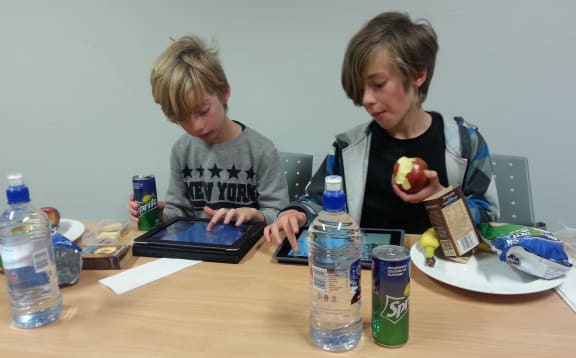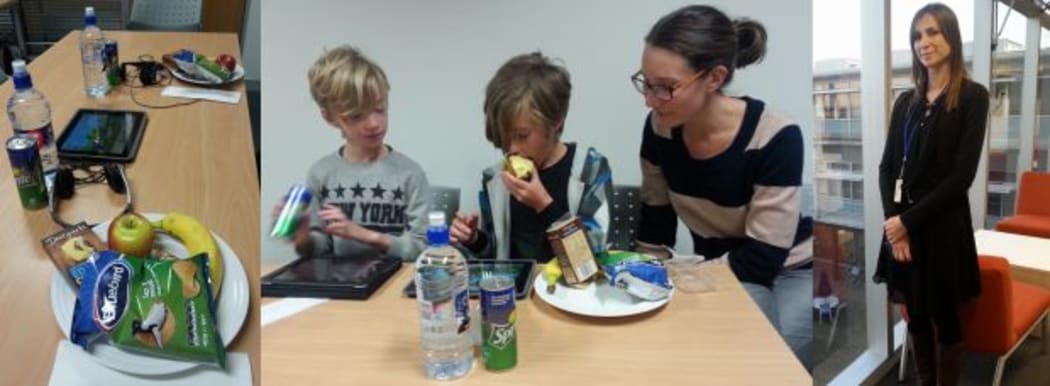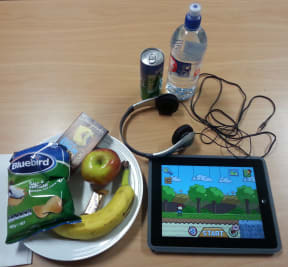By Ruth Beran
Avoid mixing screens with food.
That’s the recommendation of University of Auckland’s public health researcher Sam Marsh who has been conducting studies looking at children’s food intake when using screens like TVs and computers.
Sit at a table when you’re eating,” she says. “Talk to your kids, interact with them while they’re having their food and then if they’re going to have screen time that’s separate.”

Johan and Thurston Vogels playing on screens while eating Photo: RNZ / Ruth Beran
Sam conducted two studies to support her recommendations, the first was with 20 boys aged 9 to 13 which compared what they ate while watching TV, playing video games, and using a computer recreationally. The boys came in on three separate days using a different screen on each day. She found that the boys ate 820 kcal in an hour while watching TV, as compared with 685kcal while using the computer, and 696 kcal while playing video games.
So quite a lot of food, which is important because research shows even 100 kcal per day over a year is enough for a kid to put on weight,” she says.
The children had a selection of food, from chips and chocolate, to yoghurt, cheese and crackers, and coke and water. The food was measured before the kids came into the room, and after they left. There was a preference for the energy dense food, which was what the researchers assumed would be the case.
The study was conducted in the after school period to recreate the natural environment of coming home from school and sitting in front of TV or playing games. Sam says this was “to see how much they would eat in that really small amount of time.”

From left to right: the food placed in front of children, Johan, Thurston and Ineka Vogels, and Sam Marsh Photo: RNZ / Ruth Beran
The boys ate more while watching television, as compared to playing on the computer, which was somewhat more to playing video games. Sam says this was unexpected: “We thought they would be using their hands more and completely not eating really, but they ate a lot in all three conditions.”
At the end of the study the children were asked what they had eaten and only one child, on one occasion could remember everything they had eaten during the past hour. “Everybody else had to look at the empty wrappers to be able to tell us what they’d eaten,” says Sam. “They’re really distracted.”
The other study that Sam conducted compared watching TV with using multiple screens in the hour after school with 78 boys and girls aged 13 to 18 years. The study did not find a significant difference, but Sam says if the study was conducted again it would be done differently. “We didn’t make the kids use multiple screens at once, we just put them in a room with multiple screens and said they could use them at the same time,” she says. This makes it hard to know if there was simply no difference, or whether there was no difference between the two behaviours.

Food and drink placed in front of children while on screens Photo: RNZ / Ruth Beran
The energy intake for this study was similar though to the previous study, with the children eating 758 kcal when exposed to multiple screens, and 681 kcal with a single screen.
Sam has hypothesised as to why the children ate so much. The first is that they’re really distracted. “They’re not actually aware of what they’re eating, the food is [just] in front of them,” she says. Being distracted means the children are not aware of when they are full and also don’t remember what they’ve eaten. “If you have a meal in front of a screen, you’re more likely to eat more after as well because you can’t actually remember what you ate,” she says. Eating in front of a screen also becomes a learnt behaviour so that sitting in front of a screen like the TV is associated with food.
It’s recommended that children above five years use a screen for only two hours per day. A survey of the children in the second study found that screens were being used up to five hours a day. The hours quickly add up because children are not just watching TV, they are also using computers, iPads and even smart phones. “We haven’t done a lot of research in New Zealand on it, but in the age group two and over I think it’s around 50% of children are watching more than two hours of TV a day,” says Sam. “Which is a bit scary.”

